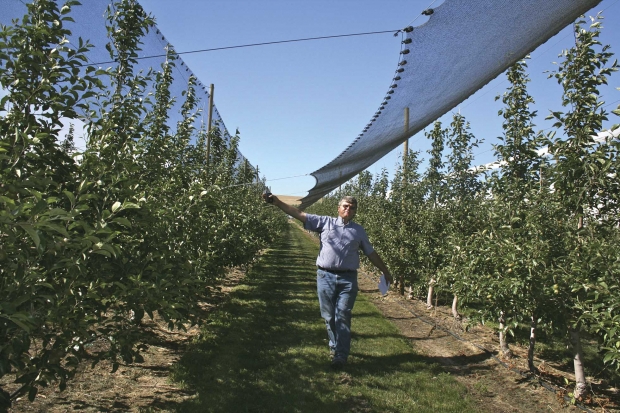
Mike Robinson can afford to install shade clothes over his Honeycrisp blocks and overhead cool at current prices. (Geraldine Warner/Good Fruit Grower)
When Honeycrisp apples were first planted in the 1990s, it was assumed that the variety would do best in the cooler apple-growing regions of the country.
“We were just so happy because Washington didn’t grow it,” Dr. Terence Robinson, research horticulturist with Cornell University, New York, said—only half joking—at the Honeycrisp Fruit School in Wenatchee, Washington, in December.
For almost a decade, the belief persisted that it could not be grown in warm regions. Honeycrisp is an apple that can grow overly large in some conditions. In New York, it was noticeable that the cooler the climate, the redder and smaller the fruit was, Terence said. And it probably had better storage quality, too.
“As time goes on, more and more has been planted in warmer climates, and I’ve been amazed how well people have been able to do it in warm sites,” he told 350 people from across the country and overseas who attended the Fruit School.
Mike Robinson, who grows Honeycrisp in a hot site near Othello in Washington’s Columbia Basin, said with the variety returning $700 a bin, he can afford all the microclimate modification it takes. He has shade structures that cost $4,000 an acre and uses evaporative cooling, too.
“You can put a lot of money into modifying the site, but it’s a disadvantage compared to anyone who doesn’t have to do that,” he said, noting that it puts a financial load on the operation.
Bruce Allen, a fruit grower and packer in Yakima, Washington, said when figuring out how much they can spend modifying the site, growers should not be thinking about current pricing of over $50 a box, but about future returns.
Can they make it work next year or in five years when prices might not be that high?
“We have probably 15 million cartons of Honeycrisp in the ground in the state of Washington, and I think it’s time to be very critical of your assumptions,” he said. “You’ve got to figure out what you need to do to make this variety work at an average price of $35 to $45 a box, not $58.
“I think as a national industry we could easily sell 20 million cartons at high prices if we can deliver high quality. But you have to pick the right site, have the right system, and be spot-on with your implementation,” he added.
Broke the price barrier
Terence Robinson said Honeycrisp pioneers, like Dennis Courtier of Pepin Heights Orchard in Lake City, Minnesota, succeeded in breaking the $30-a-box price barrier for apples. They walked into retail stores with all the confidence in the world and asked for $60 a box.
Buyers who said they would never pay that much didn’t get the apples. Three years later, they were willing to pay for them.
“There’s no reason for us as an industry to shoot ourselves in the foot by what we’re doing,” Terence said. “I guess we can’t control how much is planted, and I’m not proposing that, but we have to deliver high quality fruit, and those who are selling the fruit can’t go back to the supermarkets and offer this at $25 a box. I don’t know how to get us to collectively agree to that.
“This variety needs high prices to make it something we can deal with,” he added. “At $500 to 700 a bin, we can invest money to grow the variety. When you’re getting $150 a bin, you can’t invest any money in this thing. I would like to hear my Washington colleagues give the rest of the world some assurances that you guys are not going to blow this thing apart. Based on past history, I can assure you we will,” Mike Robinson responded, to laughter.
Courtier said the West Coast commodity model is self-defeating.
“Never forget you are growing food and people like to eat good food better than they like to eat bad food,” he said. “I’m not really worried about 15 to 20 million boxes of good Honeycrisp, but 15 million boxes of bad Honeycrisp is the end of the variety. It’s all about focusing on eating quality.”
“Amen,” rippled through the audience.
Terence Robinson said he felt there was still an untapped market for Honeycrisp because many consumers still haven’t heard of it, and he hoped the various growing regions would be able to work together to maintain the pricing structure.
The Fruit School was organized by Washington State University Extension. •

Leave A Comment